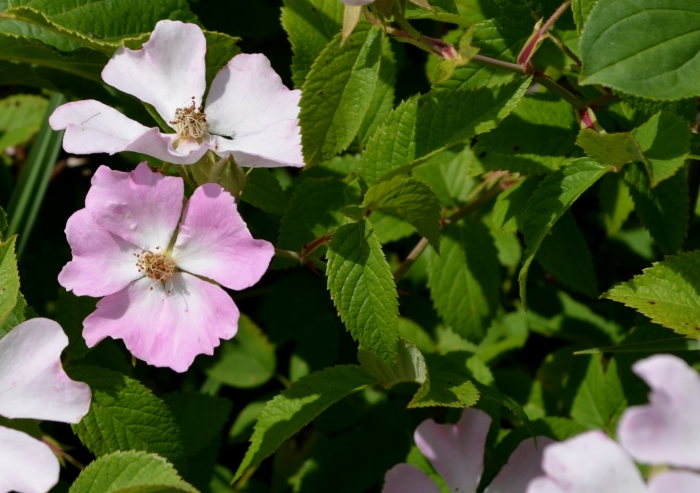Prairie Rose
(Rosa setigera)
Prairie Rose (Rosa setigera)
/
/

Evan Barker
Public Domain
Image By:
Evan Barker
Recorded By:
Copyright:
Public Domain
Copyright Notice:
Photo by: Evan Barker | License Type: Public Domain | License URL: http://creativecommons.org/publicdomain/zero/1.0/ | Rights Holder: Evan Barker | Publisher: iNaturalist | Date Created: 2016-07-03T13:55:08-07:00 |
















































Estimated Native Range
Summary
Rosa setigera, commonly known as Prairie Rose or Climbing Rose, is a deciduous perennial vine or subshrub native to open woodlands, forest edges, and prairies in the Eastern United States. It can grow to a height of 16 feet (5 meters) and a width of 8-10 feet (2.4-3 meters), with canes that are capable of climbing if given support. The Prairie Rose features compound leaves with three to seven leaflets and bears fragrant, showy flowers that are typically pink in bud, opening to white, from late spring to early summer. The flowers are followed by red rose hips that can persist into winter, providing visual interest and food for wildlife.
The Prairie Rose is valued for its ornamental flowers and its ability to attract pollinators such as bees and butterflies. It is used in naturalistic plantings, as a climbing plant on fences and trellises, and for erosion control on slopes due to its spreading habit. This species is relatively low-maintenance, tolerating a range of soil types, though it prefers well-drained soils. It is drought-tolerant once established and can thrive in full sun to part shade. While generally disease-resistant, it can be susceptible to common rose afflictions such as black spot and powdery mildew.CC BY-SA 4.0
The Prairie Rose is valued for its ornamental flowers and its ability to attract pollinators such as bees and butterflies. It is used in naturalistic plantings, as a climbing plant on fences and trellises, and for erosion control on slopes due to its spreading habit. This species is relatively low-maintenance, tolerating a range of soil types, though it prefers well-drained soils. It is drought-tolerant once established and can thrive in full sun to part shade. While generally disease-resistant, it can be susceptible to common rose afflictions such as black spot and powdery mildew.CC BY-SA 4.0
Plant Description
- Plant Type: Vine, Subshrub
- Height: 4-15 feet
- Width: 8-10 feet
- Growth Rate: Rapid
- Flower Color: Pink
- Flowering Season: Spring, Summer
- Leaf Retention: Deciduous
Growth Requirements
- Sun: Full Sun, Part Shade
- Water: Medium, High
- Drainage: Fast, Medium
Common Uses
Bee Garden, Bird Garden, Butterfly Garden, Fragrant, Hummingbird Garden, Showy Flowers
Natural Habitat
Native to open woodlands, forest edges, and prairies in the Eastern United States
Other Names
Common Names: Prairie Rose, Prärie-Rose, Prärieros
Scientific Names: , Rosa setigera, Rosa mutabilis, Rosa rubifolia, Rosa setigera var. setigera, Rosa setigera var. serena, Rosa setigera f. alba, Rosa setigera f. inermis, Rosa cursor, Rosa fenestrata
GBIF Accepted Name: Rosa setigera Michx.